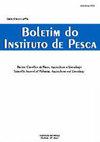Meta-analysis of 87Sr/86Sr ratios in otoliths to establish thresholds for determining fish movement
IF 0.6
4区 农林科学
Q4 FISHERIES
引用次数: 0
Abstract
Unpublished data were combined with a literature review to test a hypothesis of whether there is a pattern for classifying fish as “movers” or “residents” according to variability in strontium isotope ( 87 Sr/ 86 Sr) ratios in otoliths as a function of its environmental fingerprint. The variability in Sr ratios found in the otoliths of fish specimens as a percentage of isotopic environmental variability was used to determine the intensity of movement in a given study area (POEVSri index). A classic meta-analysis and a frequentist regression were applied to obtain a logistic model to describe the pattern. The meta-analysis returned a POEVSri limit of 28.95% for sedentary individuals and the logistic model shows a high probability of movement for POEVSri indices over 32%. There is a gradient of movement probabilities in the POEVSri interval from 8 to 32%, with each class having equal odds when POEVSri is approximately 20%. Regarding applicability for future studies, if aspects such as sufficient spatial and seasonal water sampling are addressed, the model provides two different thresholds for fish: a priori “movers” are those with POEVSri ≥ 32%, and resident fish have POEVSri ≤ 8%.对耳石中的 87Sr/86Sr 比率进行元分析,以确定鱼类移动的阈值
我们将未发表的数据与文献综述结合起来,以验证一个假设,即根据耳石中锶同位素(87 Sr/ 86 Sr)比率的变化作为环境指纹的函数,是否存在将鱼类划分为 "移动者 "或 "居住者 "的模式。根据鱼类标本耳石中锶同位素比率的变化占同位素环境变化的百分比,来确定特定研究区域的移动强度(POEVSri 指数)。通过经典的荟萃分析和频数回归,获得了描述该模式的逻辑模型。荟萃分析结果显示,久坐不动的人的 POEVSri 上限为 28.95%,而逻辑模型显示,POEVSri 指数超过 32% 的人运动的概率很高。在 POEVSri 指数从 8% 到 32% 的区间内,运动概率呈梯度变化,当 POEVSri 指数约为 20% 时,每个等级的运动概率相等。关于未来研究的适用性,如果解决了足够的空间和季节性水样等方面的问题,该模型提供了两种不同的鱼类阈值:先验 "移动者 "是指 POEVSri ≥ 32% 的鱼类,常住鱼类的 POEVSri ≤ 8%。
本文章由计算机程序翻译,如有差异,请以英文原文为准。
求助全文
约1分钟内获得全文
求助全文
来源期刊

Boletim do Instituto de Pesca
FISHERIES-ZOOLOGY
CiteScore
0.80
自引率
0.00%
发文量
24
审稿时长
>12 weeks
期刊介绍:
To publish original articles of research and short communications in the following áreas: Fisheries, Aquaculture, Zootechnology, Limnology, Oceanography, Biology and Pathology of aquatic organisms. The publication depends on the approval of the Editorial Board, based on the peer review.
 求助内容:
求助内容: 应助结果提醒方式:
应助结果提醒方式:


